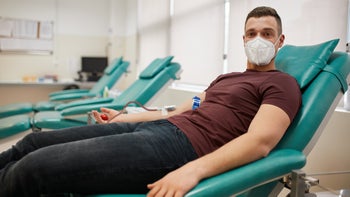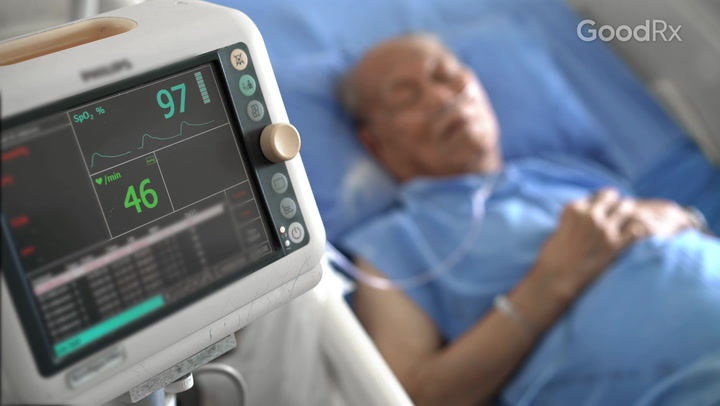
7 Xarelto Side Effects You Should Know About
Key takeaways:
Xarelto (rivaroxaban) is a medication used to treat and prevent blood clots. The most common side effect of Xarelto is minor bleeding. Other side effects include stomach pain, back pain, and itchy skin. Fatigue and dizziness are also possible.
More serious Xarelto side effects include liver problems and serious bleeding. Seek emergency care if you have bleeding that doesn’t stop or blood in your stool or urine.
Stopping Xarelto too early can make you more likely to experience a blood clot. Don’t stop taking it without talking to your prescriber, even if side effects are bothersome.
Access savings on related medications
Table of contents

Xarelto (rivaroxaban) is a blood thinner medication. It’s part of a group of medications called direct-acting oral anticoagulants (DOACs). They’re often a first-choice medication for preventing blood clots because they’re more convenient and have fewer side effects than older treatment options.
But since Xarelto treats and prevents unwanted blood clots, it can also make you bleed more easily. Here, we’ll review this and other Xarelto side effects to keep in mind.
Xarelto side effects at a glance
Below is a list of common and rare Xarelto side effects reported in clinical studies. Keep in mind that this doesn’t include all possible side effects. So it’s best to talk to your healthcare team about any Xarelto side effects you’re concerned about.
Mild Xarelto side effects include:
Minor bleeding
Stomach pain
Fatigue
Back pain
Muscle spasms
Dizziness
Trouble sleeping
Itchy skin
Pain in extremities (i.e. arms, hands, or feet)
Fainting
Blisters
Cough (more common in children)
Vomiting (more common in children)
Inflammation of the stomach and intestines (more common in children)
Rash (more common in children)
Rare but serious Xarelto side effects include:
Serious or severe bleeding
Mood changes
Liver or kidney problems
Anaphylaxis (severe allergic reaction)
Severe skin reactions
Xarelto also has two boxed warnings, the FDA’s strictest warning for medications. While rare, these warnings include:
An increased risk of blood clots if you stop taking Xarelto earlier than your prescriber tells you to
An increased risk of bleeding during certain spinal procedures
Let’s take a closer look at seven Xarelto side effects and how to manage them if they occur.
Xarelto FAQs: Learn more about how long it takes Xarelto to work and how long you’ll need to take it.
Blood thinner 101: Curious about the difference between antiplatelet versus anticoagulant medications? We’ve got you covered.
Signs of bleeding: How to recognize the signs and symptoms of internal bleeding, and when to seek help.
1. Increased risk of bleeding
Since Xarelto is a blood thinner, bleeding is the most common side effect when taking it.
You may be at a greater risk of bleeding if you:
Have a history of bleeding
Have certain medical conditions such as high blood pressure, kidney disease, or diabetes
Drink alcohol often or in large amounts
Take other medications that make bleeding more likely, such as aspirin or certain antidepressants
Are age 65 and over
Bleeding from Xarelto is usually mild. Nose bleeds, light bruising, or bleeding from the gums while brushing your teeth are examples of mild bleeding. It’s best to let your prescriber know if you experience mild bleeding symptoms. They may decide to monitor you more often.
Sometimes, bleeding from Xarelto can be severe or even life-threatening. Signs of serious bleeding include:
Bleeding that doesn’t stop
Bruising that happens without a known cause or covers a large area
Blood in your urine
Blood in your stool (either bright red or black, tarry stool)
Coughing up blood
Vomiting blood (may look like coffee grounds)
Seek medical attention immediately if you experience any of these symptoms. There are treatments available to help reverse life-threatening bleeding, such as Andexxa (andexanet alfa). These treatments are given in a hospital setting.
Good to know: Be sure to tell your healthcare team you’re taking Xarelto before having any medical or dental procedure that involves surgery. You may need to stop taking it for a certain number of days before the procedure to lower your risk of bleeding. But you should only stop taking Xarelto if a healthcare professional tells you to.
2. Back pain and muscle spasms
Back pain was reported by people taking Xarelto in clinical trials. Muscle spasms can also happen, but neither side effect is common.
You can often manage these side effects with simple at-home treatments like heat, ice, and gentle stretching. But you shouldn’t take some over-the-counter (OTC) pain medications, such as ibuprofen (Advil, Motrin) or naproxen (Aleve), without talking to your prescriber first. They can increase the chance of bleeding if you take them with Xarelto.
Contact your prescriber right away if you notice back pain along with tingling, numbness, or muscle weakness. These could be signs of a more serious issue, such as a blood clot or stroke.
3. Stomach pain
Stomach pain can happen while taking Xarelto, but it’s not common. Taking Xarelto with food may help prevent this side effect.
Stomach pain can also be an early symptom of bleeding in the stomach, so be sure to keep an eye out for any signs of bleeding as well.
If your stomach pain doesn’t go away or gets worse, be sure to let your prescriber know. They might perform tests to help determine the cause and best course of action.
4. Fatigue and dizziness
Some people report feeling tired or dizzy while taking Xarelto. These aren’t common side effects, but they’re still possible.
Exercising regularly and eating a balanced diet can help you keep your energy up. Staying hydrated can also help with energy and it may improve dizziness, too.
If you’re feeling lightheaded or dizzy while taking Xarelto, it’s best to avoid driving or other activities that require coordination. Take your time when changing positions to avoid falls.
Keep in mind that fatigue and dizziness can also be signs of blood loss. So keep an eye out for other signs of bleeding. And seek emergency care if these symptoms become severe or worsen.
5. Itchy skin
Some people may experience a feeling of itchiness while taking Xarelto. The reason Xarelto causes itchy skin isn’t clear.
Itchiness can be unpleasant and impact your quality of life. Thankfully, there are some easy ways to help manage this side effect.
Itchiness is often the result of dry skin. Creams and lotions can lock in moisture and soothe itchy skin. Apply these products several times a day (or according to package directions) for best results. Using a humidifier in the bedroom may also help keep your skin from drying out at night.
If needed, talk to your healthcare team about taking an antihistamine such as loratadine (Claritin) or diphenhydramine (Benadryl). Some case reports show that they may help reduce itchiness caused by Xarelto.
Itching may make you want to stop taking Xarelto. But don’t stop taking Xarelto on your own — talk to your prescriber first. They can help you figure out the cause of the itchiness and discuss ways to manage your symptoms. If you need to switch to a different blood thinner, they can help you do so safely without raising your risk of blood clots.
6. Blood clots
You’re more likely to experience a blood clot if you stop taking Xarelto too early. This is especially true if you’re considered at high risk for a blood clot. Blood clots are dangerous because they can lead to a life-threatening heart attack or stroke.
Your prescriber will let you know when it’s safe to stop taking Xarelto. Some people will take Xarelto for just a few weeks or months. For others, it’s a lifelong medication. You may have to stop taking Xarelto for a medical test or procedure, but you’ll typically restart it again afterward. Even if you’re experiencing side effects, don’t stop taking Xarelto without talking to your prescriber first.
Blood clots can also happen if you’re taking certain medications that interact with Xarelto and make it less effective.
Seek medical attention if you have any signs or symptoms of a blood clot while taking Xarelto. These include:
Swelling, pain, or redness in an arm or leg
Difficulty breathing
Fast or irregular heartbeat
Coughing up blood
Chest pain
Low blood pressure
7. Liver problems
In rare cases, Xarelto can cause liver problems for some people. In most cases, liver problems appear within the first 2 months (8 weeks) of starting Xarelto. But they usually resolve once you stop taking the medication.
Signs of liver problems include feeling more tired than usual and a yellowing of your skin and eyes (jaundice). If you notice these symptoms, contact your prescriber right away. They’ll be able to check your liver function to see if there’s a problem.
Frequently asked questions
No, there don’t seem to be any weight-related side effects associated with taking Xarelto. If you notice a change in your body weight while you’re taking it, talk to your healthcare team to determine the cause. It’s likely related to something other than Xarelto.
Taking Xarelto in the evening may help protect you during early morning hours, when your risk of dangerous blood clots is higher. Evening Xarelto doses also seem to provide higher and longer-lasting blood levels of the medication, which may improve its effectiveness. Finally, taking Xarelto doses of 15 mg or more with your largest meal of the day (which is in the evening for most people) helps your body absorb the medication better.
No, you don’t have to avoid specific foods while taking Xarelto the way you do with warfarin (Coumadin, Jantoven). But you should limit the amount of grapefruit and grapefruit juice you consume. Large amounts of grapefruit may raise Xarelto levels in the body and increase your risk of bleeding. But small amounts now and then aren’t likely to cause an issue.
The bottom line
Xarelto (rivaroxaban) is a blood thinner used to treat and prevent blood clots. The most common Xarelto side effect is minor bleeding, but it can also cause back pain, stomach pain, and itchy skin. You may also feel dizzy or tired while taking Xarelto, but this isn’t common.
More serious Xarelto side effects include serious bleeding and liver problems. Seek medical care if you notice signs or symptoms of these side effects.
If you have mild bleeding while taking Xarelto, such as nosebleeds or light bruising, contact your prescriber. Seek emergency care if you have bleeding that doesn’t stop or blood in your stool or urine.
Even if side effects are bothersome, don’t stop Xarelto without talking to your prescriber first. This could make you more likely to experience a life-threatening blood clot.
Why trust our experts?



References
Amaraneni, A., et al. (2023). Anticoagulation safety. StatPearls.
Brunner-Zieglar, S., et al. (2016). Comparison between the impact of morning and evening doses of rivaroxaban on the circadian endogenous coagulation rhythm in healthy subjects. Journal of Thrombosis and Haemostasis.
Centers for Disease Control and Prevention. (2023). Know the risks, signs & symptoms of blood clots.
Gerber, G. F. (2024). Anemia due to excessive bleeding. Merck Manual Consumer Version.
Grześk, G., et al. (2021). The clinical significance of drug–food interactions of direct oral anticoagulants. International Journal of Molecular Sciences.
Joglar, J. A., et al. (2023). 2023 ACC/AHA/ACCP/HRS guideline for the diagnosis and management of atrial fibrillation: A report of the American College of Cardiology/American Heart Association joint committee on clinical practice guidelines. Circulation.
Kirchhof, P., et al. (2020). Impact of modifiable bleeding risk factors on major bleeding in patients with atrial fibrillation anticoagulated with rivaroxaban. Journal of the American Heart Association.
LiverTox: Clinical and Research Information on Drug-Induced Liver Injury. (2023). Rivaroxaban. National Institute of Diabetes and Digestive and Kidney Diseases.
Macleods Pharmaceuticals. (2025). Rivaroxaban - rivaroxaban tablet, film coated [package insert].
Nassif, D., et al. (2017). Medication-induced pruritus from direct oral anticoagulants. Federal Practitioner.
Scheer, F. A. J. L., et al. (2013). Human circadian system causes a morning peak in prothrombotic plasminogen activator inhibitor-1 (PAI-1) independent of the sleep/wake cycle. Blood.
Sikorska, J., et al. (2017). Direct oral anticoagulants: A quick guide. European Cardiology Review.
Was this page helpful?
Related Articles
Browse medications
View AllResearch prescriptions and over-the-counter medications from A to Z, compare drug prices, and start saving.


















